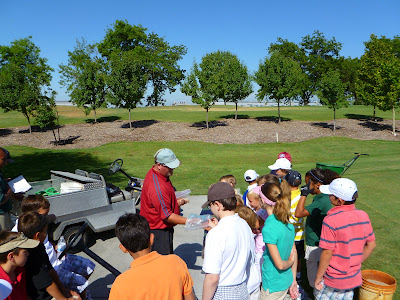Cup O' Bermuda
During the fertilizer portion, we offered the attendees the chance to use a spreader across the driving range tee with a little gypsum. Most of the time, the handle bars were above the operator's head, but they seemed to enjoy it. A usual favorite is the radio controlled irrigation and they all cheered when the heads popped up one fairway away.
Tree Program: Say goodbye to the redwoods
 I would like to be more optimistic about the condition of SGCC's many redwoods, but the realist in me refuses to ignore the signs of decline. Redwoods seemed to be the tree to plant as they are fast growing, evergreen, and fairly durable. They are not native to this region, but driving around town, you'd never know as they've become a favorite for homeowner landscapes and street borders. In fact, I will be planting a few in my yard just 30 minutes north and they will do just fine.
I would like to be more optimistic about the condition of SGCC's many redwoods, but the realist in me refuses to ignore the signs of decline. Redwoods seemed to be the tree to plant as they are fast growing, evergreen, and fairly durable. They are not native to this region, but driving around town, you'd never know as they've become a favorite for homeowner landscapes and street borders. In fact, I will be planting a few in my yard just 30 minutes north and they will do just fine.So why are the redwoods that line the fairways and dot the rough slowly fading into firewood? Two reasons: sodium buildup in the soil and a high water table.
Our water source isn't the worst water out there, but it isn't the best either. Coupled with our dense clay soils and high water table, the sodium present in our water builds to levels toxic to redwoods. We've tried to flush the soil surrounding these trees using gypsum and heavy irrigation just as we would the greens. A flush on the greens requires nearly 6 inches of irrigation to drop the sodium by 50% in a sand green. This is with water flowing through the profile at a decent rate. That kind of drainage is not possible around the redwoods.

Share Buttons
Flex Your Power
No word is the good word

If the soil gets out of balance with sodium topping potassium and many other nutrient ratios out of whack, bad things will happen. Back in 2006, my first summer as Superintendent (lucky it wasn't my last), the instrument I use to test bicarbonates in the soil was not calibrated correctly and the stuff hit the fan.
It's hard to keep down your lunch when a few of the greens look like this:

Now the greens look like this and lunch is easy to enjoy once again.
The staff has done a great job this year and each and every day they continue to improve the conditions we offer the membership. There is still a ton of work to do and we have a massive list to prove it. One item was: write a positive blog today. Check. Done. What's next?
Junior Camp 2010










